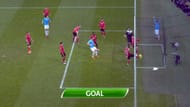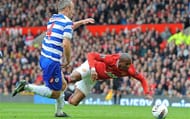Using technology in football has always been a pretty controversial issue. In football, referees have to literally be active for the entirety of 90 minutes and have to make an average of one decision per minute. As a result, using technology for the every decision in the match may prove to be difficult and may contribute to a reduction in the speed of the game. On the other hand, a lot of matches have been decided by refereeing mistakes which could have been avoided had the technology been in place.
1) The Goal line troubles
Frank Lampard’s disallowed goal against Germany in the 2010 World Cup is one of the major decisions that comes to mind when you think of major impacts caused by refereeing mistakes. It was responsible for ending the hopes of England. FIFA acted promptly since and has introduced the goal line technology which will make sure that similar errors do not take place in future World Cups.
The proportion of mistakes caused by goal line errors is very small to the total errors but as the mistakes have a direct bearing on the final score, the impact of this technology is quite huge.
2) The Offside Call Issues
Didier Drogba’s offside goal against United in what eventually proved to be the title decider in 2010 was one of the major talking points that season. And four years down the line, the match-up between Liverpool and City was also decided by a dubious offside call which may yet affect another title swing though this time in favour of Manchester.
A report on BBC’s website states: Assistant referees get nearly 10% of offside decisions wrong because they are not standing in the right place.However, a research team showed that it is not always the officials’ fault, but is “inevitable” because of the “limitations” of human eyes. A report published in the journal Nature shows that in-built human error will always remain, and that no assistant referee can keep up with the speed of today’s fast-moving game.
Most of the offside decisions more or less result in a goal scoring opportunity. As a result, it is necessary that FIFA should look into using technology for increased accuracy of these calls given the human limitations cited in the above report.
Certain decisions like Sterling’s offside call in the Liverpool vs City match were pretty straight-forward and technology intervention should have been in place to make the correct decision.
3) Penalties and Red Cards
Once again, the objectivity of the decisions plays an important role in preventing the usage of technology for penalties and red cards. In case of decisions which cannot be reviewed because of its vague nature, referee’s verdict should stand. But in cases, where the decisions are crystal clear such as De Jong’s kung fu kick on Xabi Alonso, video referrals should be used to make the decisions.
Usually after a penalty or a red card or a really aggressive tackle, a lot of time is spent in arguing about the correctness of the call. This time can certainly be utilized to make sure that the call made was indeed correct. On an average, a team argues for around 45 seconds after a penalty is awarded or a red card is shown. This time should be enough to certify the accuracy of the decisions.
The issue with the above technique is that only when a penalty or a red card is shown, the decision verification technique will come into play. But it cannot be used when the play is continued as by the time a verdict is reached, an event such as counter attack can be launched which may result in a goal largely affecting the outcome of the game as the team shape is usually in a disarray when such decisions are given.
4) Corner kicks and throw-ins
Certain other decisions such as whether a team wins a corner or not or which team gets the throw in are so commonplace that using technology for such decisions is practically impossible unless an instantaneous review system is developed.
5) The Decision Referral System
After each and every match, a system must be in place to ensure that all the major decisions taken during the match are indeed correct. While this review system is in place in all the major leagues, it is currently only being used for decisions which have missed the attention of the referee and the fourth official.
Given that most of the controversial decisions in football are pretty obscure, it is extremely difficult to give a verdict about every decision and hence only a handful of cases are reviewed. In order to improve the game though, the governing bodies of the league should broaden the scope of this review system to other cases such as:
- a. Diving
If a player has not been yellow carded for diving during the match, then provisions should be made to punish the player after the match. If there is absolutely no contact between the player and the defender then in such cases a yellow card should be mandatory after the match. Repeated offenders should be banned. This is an important step and will make sure that it frees football from the curse of diving.
- b. Aggressive tackles
In 2010, Aaron Ramsey was supposed to be the next big superstar in the Premier League. A Ryan Shawcross tackle was all that was required to fracture his foot in two places. Shawcross got a mandatory red card and a three match ban but Ramsey’s career was in tatters. There were doubts if he would be ever able to make his comeback.
The question one would like to pose is if a three match ban is sufficient for such tackles? Are these tackles in any way less harmful than a bite for which a ten game ban was awarded?
This was a case when the offender was punished but there are many cases when such tackles have been overlooked just because the referee saw it but failed to realize its cynical nature. Such decisions should also be looked into and retrospective actions should be taken against offenders to make sure that irresponsible actions are not repeated which have been responsible for bringing many footballing careers to a premature end.
What Fabregas says in this video is very important and it is a surprise why nothing has been done to ensure the safety of the players on the field from such Pulis-ian tactics.
Technologies
1) Goal-line technology
Goal-line technology has been used to determine if the ball has completely crossed the goal line with the assistance of electronic devices. An electronic sound is transmitted to the referee in case the ball has crossed the line. The goal line technology is only used as an aide for the referees and the final decisions are at the complete discretion of the referees. This technology has already been used in Confederations Cup, Euro 2012 and the current season of English Premier League and will be in use in the 2014 FIFA World Cup and the Bundesliga next season.
In last season’s Premier League, there were 31 incidents in which the Goal Decision System would have helped to correct three mistakes during 380 games.
2) Hawk Eye Technology
This is another type of goal line technology but is supposed to be more advanced. This technology utilises high frame reate cameras and cutting edge vision processing techniques to predict the trajectory of the football. This technology is already being used in cricket and tennis and is well placed to replace the goal line technology sooner rather than later.
It was announced on 16 December 2013 that the Hawk-Eye technology will be used in three of the four quarter finals in the Capital One cup and was successfully used to allow a Lee Cattermole goal in the Chelsea Sunderland quarter final clash.
3) Video Referrals
Similar to cricket, hockey and tennis, there have been calls to allow teams to challenge the decisions of the referees if the teams are absolutely certain that an error has been committed. The use of video referrals by the teams can be limited to 1 per game and should only be used to make major decisions such as penalties or red cards or offside calls where the goal has already been scored before the flag was raised. The limited referrals will allow the teams to only contest the decisions if they are absolutely sure while at the same time ensuring improved accuracy.
4) Tags/Sensors for making offside calls
A researcher on BBC’s website claims that tags can be used to track the players and the ball within five centimetres. He suggested three possible techniques: Using Radio Frequency identification (RFID), Satellite tracking and video content analysis. The former technique can prove to be a cost alternative option though may have have slightly larger errors.
The technique for using this technology has been described in more detail in: http://podospherology.com/offsidedetection.pdf
Conclusion
Goal line technology has been an excellent addition to the game of football and Hawk Eye has also started to prove its worth. As the goal line decisions have binary outcomes it is not difficult to use technology for such decisions, but most of the other decisions involve a bit of subjectivity. Besides, there are many people like Michael Platini, FIFA’s current chief who have been vociferously opposing too much technology intervention in football.
As has been observed by the successful application of technology in tennis, hockey and to some extent in cricket, effective technology not only helps in improving the decision making by reducing human errors but also ensures that the matches are at the heart of discussions on sports bars and not controversial decisions. As a result, it is essential that world governing body of football FIFA welcomes and encourages technology with open arms as soon as possible.


